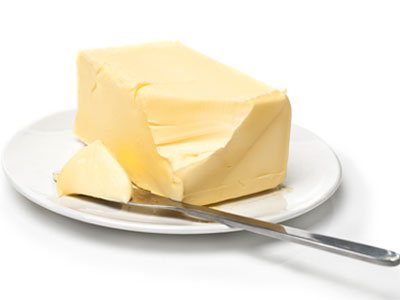Can we make butter?
How does this align with my curriculum?
Do you like butter? Find out how easy it is to make!
What You Need
- 60 mL (~1/4 cup) whipping cream
- Small, clear plastic container with a lid
- Cracker or slice of bread
Safety First!
Be careful working with liquids. They can be slippery if spilled. Adult assistance is needed for young children when using liquids.
What To Do
- Pour the cream into the container and immediately tighten the lid. Is the cream a liquid or a solid?
- Shake the cream for a few minutes. Has the cream changed? Do you see a liquid or a solid? (You should see a small ball forming and some watery looking liquid.)
- Continue shaking the container until a well-defined ball has formed. Is the ball a solid or a liquid? Pour off the liquid (this is called buttermilk; you can taste it if you like!). Taste the remaining unsalted butter by spreading it on a cracker or bread. If desired, salt can be added to taste.
Discovery
Cream (and milk) is a mixture of molecules that dissolve in water and molecules that make up fat. Normally in cream, the tiny fat molecules are suspended throughout the non-fat liquid and cannot be seen. When the cream is shaken, the fat molecules bump into each other, stick together and start to form a ball. Some of the non-fat parts get trapped in the ball as well. The ball that forms is butter and the remaining liquid is buttermilk.
Fascinating fact:
It takes 21 kg (~45 lbs) of fresh milk to make 1 kg (~2 lbs) of butter.
Many of the foods we eat come from other common foods. Understanding the components and learning how you can get a solid from a liquid are both interesting to know, as well as a good way to determine if liquids contain fat.
- Cream is very high in fat. Do you think you could get the same results if you were to use table cream or homogenized milk?
- What happens when you melt butter? Can you still get some liquid and some solid when the melted butter cools, or does it all become solid?
For more information on this topic check out these Let's Talk Science resources:
- What happens when we mix liquids? (Hands-on Activities) - Mix it up! What happens when you mix different liquids? Learn about the properties of liquids as you get mixing.
- Properties of Liquids and Solids (Lessons) - Students develop and apply observing, comparing & contrasting and predicting skills as they explore the properties of common liquids and solids.
What’s happening?
Cream (and milk) is a mixture of molecules that dissolve in water and molecules that make up fat. Normally in cream, the tiny fat molecules are suspended throughout the non-fat liquid and cannot be seen. When the cream is shaken, the fat molecules bump into each other, stick together and start to form a ball. Some of the non-fat parts get trapped in the ball as well. The ball that forms is butter and the remaining liquid is buttermilk.
Fascinating fact:
It takes 21 kg (~45 lbs) of fresh milk to make 1 kg (~2 lbs) of butter.
Why does it matter?
Many of the foods we eat come from other common foods. Understanding the components and learning how you can get a solid from a liquid are both interesting to know, as well as a good way to determine if liquids contain fat.
Investigate further
- Cream is very high in fat. Do you think you could get the same results if you were to use table cream or homogenized milk?
- What happens when you melt butter? Can you still get some liquid and some solid when the melted butter cools, or does it all become solid?
For more information on this topic check out these Let's Talk Science resources:
- What happens when we mix liquids? (Hands-on Activities) - Mix it up! What happens when you mix different liquids? Learn about the properties of liquids as you get mixing.
- Properties of Liquids and Solids (Lessons) - Students develop and apply observing, comparing & contrasting and predicting skills as they explore the properties of common liquids and solids.
